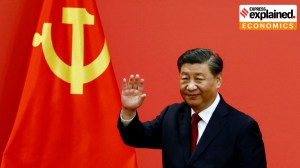How India may gain from relatively lower tariff rate: Foreign inflows likely to rise
India has been in talks with the US for a trade agreement and both sides are soon expected to arrive at a common ground.
 On Wednesday, President Trump announced sweeping reciprocal tariffs on its trading partners. In the case of India, the tariff imposed is 27 per cent. (Express File Photo)
On Wednesday, President Trump announced sweeping reciprocal tariffs on its trading partners. In the case of India, the tariff imposed is 27 per cent. (Express File Photo)US President Donald Trump’s announcement to impose lower reciprocal tariffs on India compared to other Asian countries will give India a competitive advantage over its peers and attract higher foreign inflows into the domestic market, experts say.
On Wednesday, President Trump announced sweeping reciprocal tariffs on its trading partners. In the case of India, the tariff imposed is 27 per cent. This rate is much lower than 34 per cent imposed on China, 46 per cent on Vietnam, 37 per cent on Bangladesh and 36 per cent on Thailand.
“Exporters are going to benefit given the preferred tariff rates for India vis-a-vis the other economies of the globe, especially Asia Pacific. Now, India is going to have a better advantage in terms of exporting at a lower cost, and that will tantamount to better profitability, and earnings growth cycle in the country. This, in turn, will attract further investments into India, especially from foreign investors,” said Akhil Puri, partner, financial advisory, Forvis Mazars in India.
All export-oriented sectors, such as auto, textile and minerals, are going to reap the benefits.
“In the textile segment, our major competitor is Bangladesh. After the political upheaval in Bangladesh, customers are looking at India. Now, with higher tariffs on Bangladesh, India is better placed,” said an analyst.
Lower tariffs directly reduce the cost of doing business, making Indian markets more attractive than high-tariff economies. This competitive edge encourages FIIs to invest larger capital amounts, anticipating higher returns in a lower-barrier trade environment, he said
A favorable tariff structure also signals a business-friendly climate, leading to immediate foreign capital influx and increased investor confidence, Puri said.
“Over the medium to long term, sustaining these (FIIs) inflows will depend on stable trade policies and investor-friendly regulations. If India maintains a predictable policy environment, lower tariffs could ensure a steady and stable stream of FII investments,” he said.
India has been in talks with the US for a trade agreement and both sides are soon expected to arrive at a common ground.
After incessantly selling for months, foreign portfolio investors changed their strategy and became buyers of domestic stocks. The modest buying by FPI was visible in the week ending March 21, which further increased in the week ended March 28.
Big buying by FPIs during the last several days of March substantially reduced the total FPI selling in the month to Rs 6,027 crore. Since FPIs invested Rs 2,055 crore through the primary market, the net FPI sell figure for March is down at only Rs 3,973 crore.
The re-emergence of FIIs as buyers contributed to nearly six per cent recovery in Nifty. The factors that resulted in recent buying by foreign investors included valuation in the domestic market turning attractive, recent appreciation in the rupee and improvement in India’s macros such as gross domestic product (GDP), IIP and CPI inflation, according to VK Vijayakumar, Chief Investment Strategist, Geojit Investments Ltd.
The real GDP picked up pace sequentially to grow at 6.2 per cent in October-December 2024 (Q3 of 2024-25 or FY25) compared with 5.6 per cent in July-September 2024 (Q2) quarter. Consumer price inflation (CPI), or retail inflation eased to a seven-month low of 3.61 per cent in February, compared to 4.26 per cent in January.



- 01
- 02
- 03
- 04
- 05



























